2004 SUBARU OUTBACK tire size
[x] Cancel search: tire sizePage 335 of 525

8-16
Driving tips
models
Driving on snowy grades or icy roads may require the
use of tire chains, in which case put the chains on the
front wheels only. Use only SAE class S type chains
that are of the correct size for your tires so as not to
damage the vehicle body or suspension.
When driving with tire chains, drive at speeds below
19 mph (30 km/h). When a temporary spare tire is on
a front wheel, replace the temporary spare tire with the
rear tire on the same side of the vehicle, and then fit
chains on the front tires.
Always use the utmost care when driving with tire
chains – overconfidence because you are driving with
tire chains could easily lead to a serious accident. �„ Rocking the vehicle
If you must rock the vehicle to free it from snow, sand,
or mud, depress the accelerator pedal slightly and
move the selector lever back and forth between “D”
and “R” repeatedly. Do not race the engine. For the
best possible traction, avoid spinning the wheels when
trying to free the vehicle.
When the road surface is extremely slippery, you can
obtain better traction by starting the vehicle with the transmission in 2nd than 1st (both for MT and AT).
Refer to the “Automatic transmission” section in chap-
ter 7 for information on holding the transmission in 2nd position.
Page 356 of 525
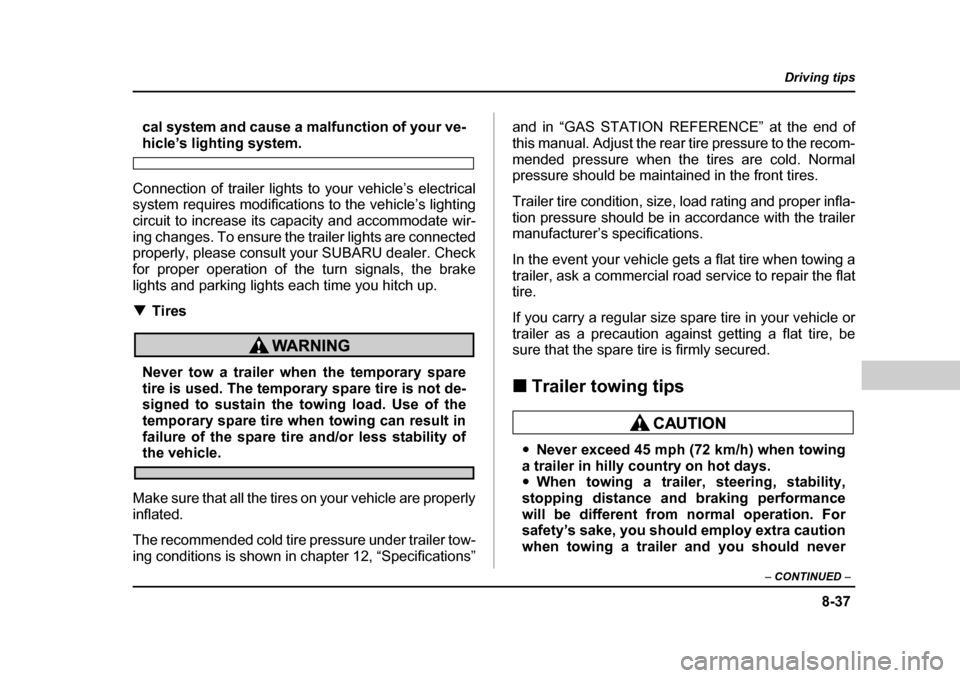
8-37
Driving tips
– CONTINUED –
cal system and cause a malfunction of your ve-
hicle’s lighting system.
Connection of trailer lights to your vehicle’s electrical
system requires modifications to the vehicle’s lighting
circuit to increase its capacity and accommodate wir-
ing changes. To ensure the trailer lights are connected
properly, please consult your SUBARU dealer. Check
for proper operation of the turn signals, the brake
lights and parking lights each time you hitch up. �T Tires
Never tow a trailer when the temporary spare
tire is used. The temporary spare tire is not de-
signed to sustain the towing load. Use of the
temporary spare tire when towing can result in
failure of the spare tire and/or less stability of
the vehicle.
Make sure that all the tires on your vehicle are properly
inflated.
The recommended cold tire pressure under trailer tow-
ing conditions is shown in chapter 12, “Specifications” and in “GAS STATION REFERENCE” at the end of
this manual. Adjust the rear tire pressure to the recom-
mended pressure when the tires are cold. Normal
pressure should be maintained in the front tires.
Trailer tire condition, size, load rating and proper infla-
tion pressure should be in accordance with the trailer
manufacturer’s specifications.
In the event your vehicle gets a flat tire when towing a
trailer, ask a commercial road service to repair the flat
tire.
If you carry a regular size spare tire in your vehicle or
trailer as a precaution against getting a flat tire, be
sure that the spare tire is firmly secured. �„
Trailer towing tips�yNever exceed 45 mph (72 km/h) when towing
a trailer in hilly country on hot days. �y When towing a trailer, steering, stability,
stopping distance and braking performance
will be different from normal operation. For
safety’s sake, you should employ extra caution
when towing a trailer and you should never
Page 362 of 525

9-3
In case of emergency
– CONTINUED –
Temporary spare tire
Never tow a trailer when the temporary spare
tire is used. The temporary spare tire is not de-
signed to sustain the towing load. Use of the
temporary spare tire when towing can result in
failure of the spare tire and/or less stability of
the vehicle and may lead to an accident.
Never use any temporary spare tire other than
the original. Using other sizes may result in se-
vere mechanical damage to the drive train of
your vehicle.
The temporary spare tire is smaller and lighter than a
conventional tire and is designed for emergency use
only. Remove the temporary spare tire and re-install
the conventional tire as soon as possible because the
spare tire is designed only for temporary use.
Check the inflation pressure of the temporary spare
tire periodically to keep the tire ready for use. The cor- rect pressure is
60 psi (420 kPa, 4.2 kg/cm 2
).
When using the temporary spare tire, note the follow-
ing: �y Do not exceed 50 mph (80 km/h).
�y Do not put a tire chain on the temporary spare tire.
Because of the smaller tire size, a tire chain will not fit
properly. �y Do not use two or more temporary spare tires at the
same time. �y Do not drive over obstacles. This tire has a smaller
diameter, so road clearance is reduced.
1) Tread wear indicator bar
2) Indicator location mark
1
2
UG0106
Page 449 of 525
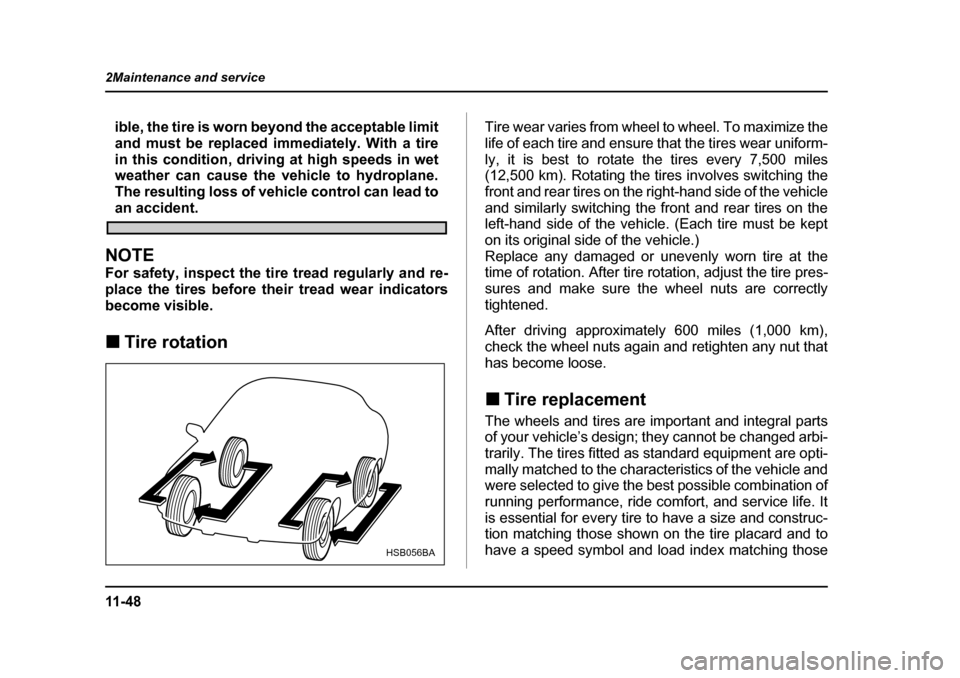
11 - 4 8
2Maintenance and service
ible, the tire is worn beyond the acceptable limit
and must be replaced immediately. With a tire
in this condition, driving at high speeds in wet
weather can cause the vehicle to hydroplane.
The resulting loss of vehicle control can lead to
an accident.
NOTE
For safety, inspect the tire tread regularly and re-
place the tires before their tread wear indicators
become visible. �„
Tire rotation Tire wear varies from wheel to wheel. To maximize the
life of each tire and ensure that the tires wear uniform-
ly, it is best to rotate the tires every 7,500 miles
(12,500 km). Rotating the tires involves switching the
front and rear tires on the right-hand side of the vehicle
and similarly switching the front and rear tires on the
left-hand side of the vehicle. (Each tire must be kept
on its original side of the vehicle.)
Replace any damaged or unevenly worn tire at the
time of rotation. After tire rotation, adjust the tire pres-
sures and make sure the wheel nuts are correctly
tightened.
After driving approximately 600 miles (1,000 km),
check the wheel nuts again and retighten any nut that
has become loose. �„
Tire replacement
The wheels and tires are important and integral parts
of your vehicle’s design; they cannot be changed arbi-
trarily. The tires fitted as standard equipment are opti-
mally matched to the characteristics of the vehicle and
were selected to give the best possible combination of
running performance, ride comfort, and service life. It
is essential for every tire to have a size and construc-
tion matching those shown on the tire placard and to
have a speed symbol and load index matching those
HSB056BA
Page 450 of 525
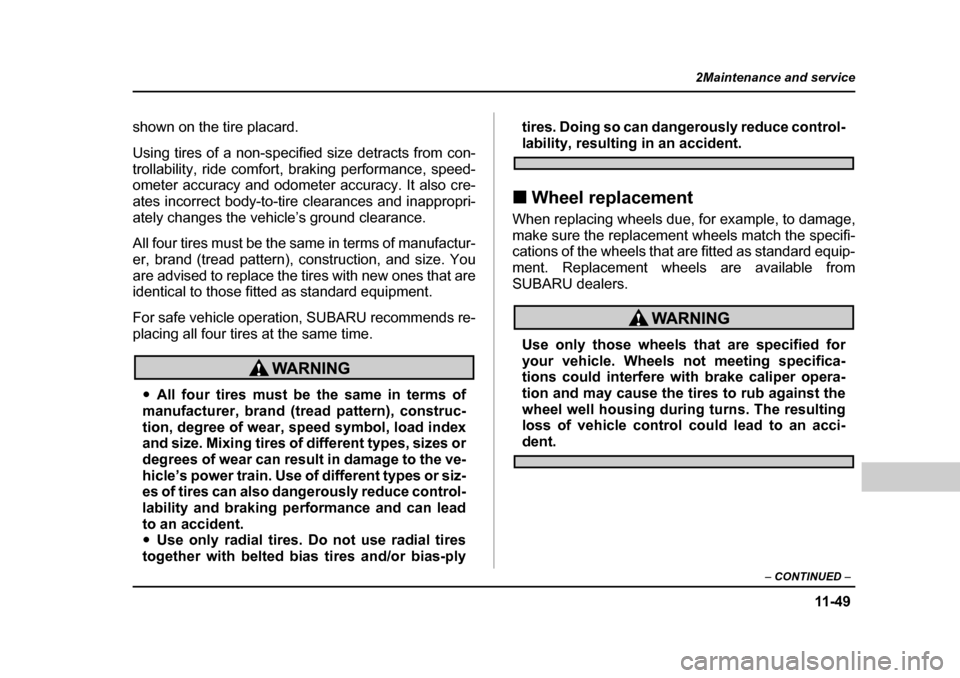
11 -4 9
2Maintenance and service
– CONTINUED –
shown on the tire placard.
Using tires of a non-specified size detracts from con-
trollability, ride comfort, braking performance, speed-
ometer accuracy and odometer accuracy. It also cre-
ates incorrect body-to-tire clearances and inappropri-
ately changes the vehicle’s ground clearance.
All four tires must be the same in terms of manufactur-
er, brand (tread pattern), construction, and size. You
are advised to replace the tires with new ones that are
identical to those fitted as standard equipment.
For safe vehicle operation, SUBARU recommends re-
placing all four tires at the same time.
�yAll four tires must be the same in terms of
manufacturer, brand (tread pattern), construc-
tion, degree of wear, speed symbol, load index
and size. Mixing tires of different types, sizes or
degrees of wear can result in damage to the ve-
hicle’s power train. Use of different types or siz-
es of tires can also dangerously reduce control-
lability and braking performance and can lead
to an accident. �y Use only radial tires. Do not use radial tires
together with belted bias tires and/or bias-ply tires. Doing so can dangerously reduce control-
lability, resulting in an accident.
�„ Wheel replacement
When replacing wheels due, for example, to damage,
make sure the replacement wheels match the specifi-
cations of the wheels that are fitted as standard equip-
ment. Replacement wheels are available from
SUBARU dealers.
Use only those wheels that are specified for
your vehicle. Wheels not meeting specifica-
tions could interfere with brake caliper opera-
tion and may cause the tires to rub against the
wheel well housing during turns. The resulting
loss of vehicle control could lead to an acci-
dent.
Page 486 of 525
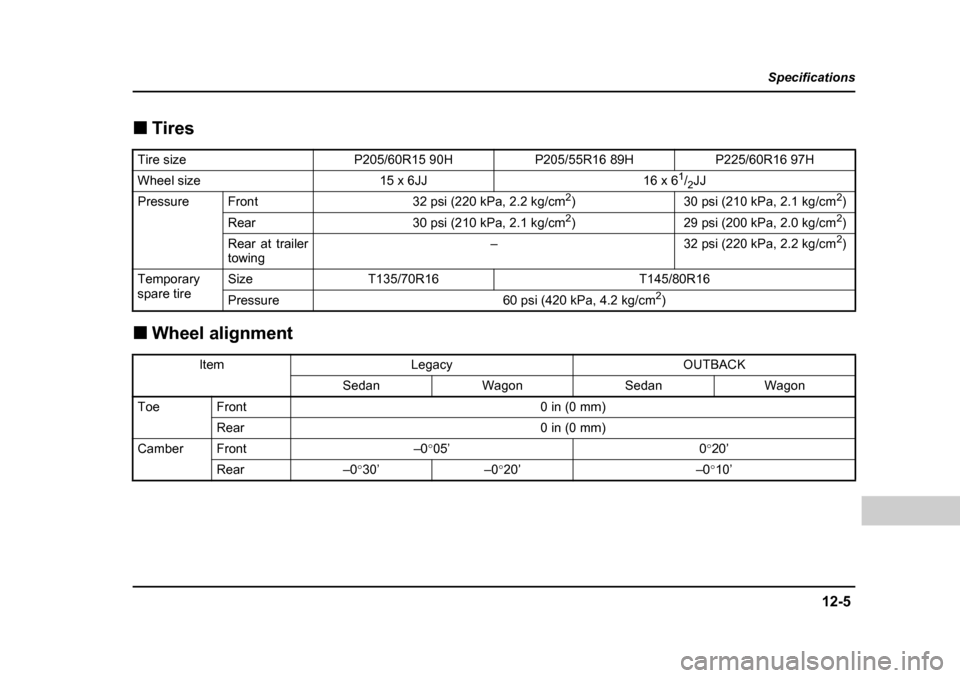
12-5
Specifications
– CONTINUED –
�„Tires
�„ Wheel alignment
Tire sizeP205/60R15 90HP205/55R16 89HP225/60R16 97H
Wheel size15 x 6JJ16 x 6 1
/2 JJ
PressureFront32 psi (220 kPa, 2.2 kg/cm 2
)30 psi (210 kPa, 2.1 kg/cm 2
)
Rear30 psi (210 kPa, 2.1 kg/cm 2
)29 psi (200 kPa, 2.0 kg/cm 2
)
Rear at trailer
towing–32 psi (220 kPa, 2.2 kg/cm 2
)
Temporary
spare tireSizeT135/70R16T145/80R16
Pressure60 psi (420 kPa, 4.2 kg/cm 2
)
ItemLegacyOUTBACK
SedanWagonSedanWagon
ToeFront0 in (0 mm)
Rear0 in (0 mm)
CamberFront–0 °05’0 °20’
Rear–0 °30’–0 °20’–0 °10’
Page 497 of 525
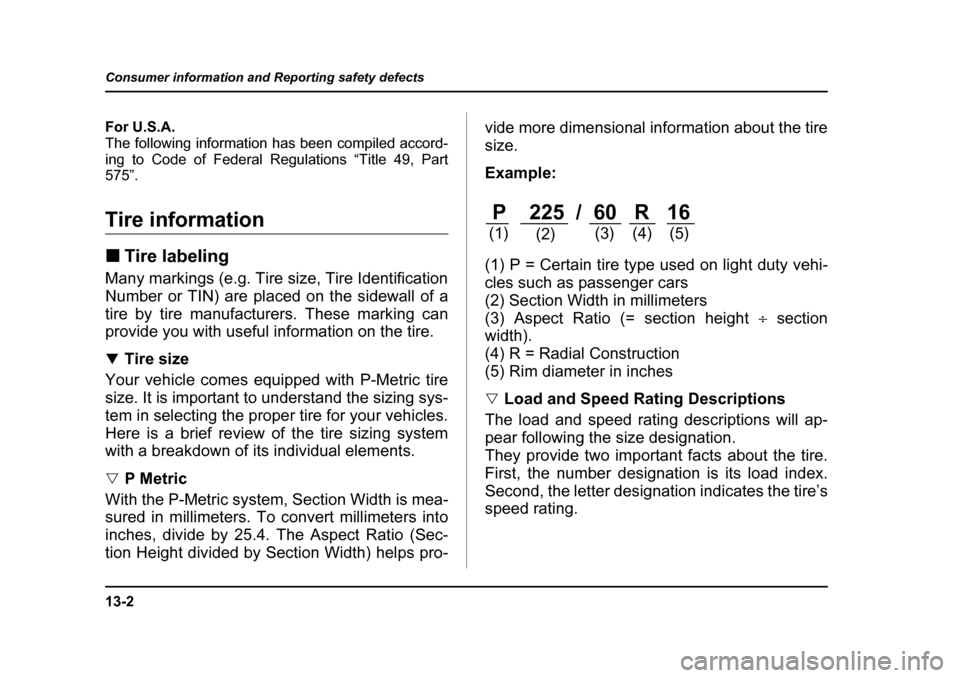
13-2
Consumer information and Reporting safety defects
Consumer information and Reporting safety defectsFor U.S.A.
The following information has been compiled accord-
ing to Code of Federal Regulations “Title 49, Part
575”.
Tire information �„
Tire labeling
Many markings (e.g. Tire size, Tire Identification
Number or TIN) are placed on the sidewall of a
tire by tire manufacturers. These marking can
provide you with useful information on the tire. �T Tire size
Your vehicle comes equipped with P-Metric tire
size. It is important to understand the sizing sys-
tem in selecting the proper tire for your vehicles.
Here is a brief review of the tire sizing system
with a breakdown of its individual elements. �V P Metric
With the P-Metric system, Section Width is mea-
sured in millimeters. To convert millimeters into
inches, divide by 25.4. The Aspect Ratio (Sec-
tion Height divided by Section Width) helps pro- vide more dimensional information about the tire
size. Example:
(1) P = Certain tire type used on light duty vehi-
cles such as passenger cars (2) Section Width in millimeters
(3) Aspect Ratio (= section height
÷ section
width).
(4) R = Radial Construction
(5) Rim diameter in inches �V Load and Speed Rating Descriptions
The load and speed rating descriptions will ap-
pear following the size designation.
They provide two important facts about the tire.
First, the number designation is its load index.
Second, the letter designation indicates the tire’s
speed rating.P 225 / 60 R 16
(1) (2) (3) (4) (5)
Page 498 of 525

13-3
Consumer information and Reporting safety defects
– CONTINUED –
Example:
(6) Load Index: A numerical code which specifies
the maximum load a tire can carry at the speed
indicated by its speed symbol, at maximum infla-
tion pressure.
For example, “97” means 1,609 lbs (730 kg), “90”
means 1,323 lbs (600 kg), “89” means 1,278 lbs (580 kg)
Load indices apply only to the tire, not to
the vehicle. Putting a load rated tire on any
car does not mean the car can be loaded
up to the tire’s rated load.
(7) Speed Rating: An alphabetical system de-
scribing a tire’s capability to travel at established
and predetermined speeds.
For example, “H” means 130 mph (210 km/h)
�y Speed ratings apply only to the tire, not
to the vehicle. Putting a speed rated tire on
any car does not mean the car can be op-
erated at the tire’s rated speed. �y The speed rating is void if the tires are
worn out, damaged, repaired, retreaded, or
otherwise altered from their original condi-
tion. If tires are repaired, retreaded, or oth-
erwise altered, they may not be suitable for
original equipment tire designed loads and
speeds.
�T Tire Identification Number (TIN)
Tire Identification Number (TIN) is marked on the
intended outboard sidewall. The TIN is com-
posed of four groups. Here is a brief review of the
TIN with a breakdown of its individual elements.
(1) Manufacturer’s Identification Mark
P 225 / 60 R 16 97 H Size designation (6) (7)
DOT XX XX XXX XXXX
(1) (2) (3)(4)